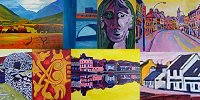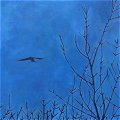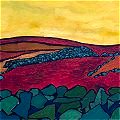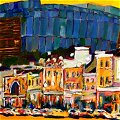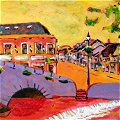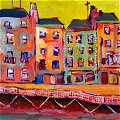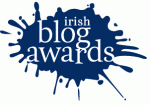Learn Irish / Gaeilge / Gaelic - Lesson 010
PRONUNCIATION
You know by now how to pronounce broad “c” and “g”. These sounds occur when the nearest vowel in the word is “a”, “o”, or “u”. The sounds in general resemble those in the English words “coal” and “go”. In some Irish words, however, a sound resembling the (uh) sound follows the “c” or “g”. The groups “cao” and “caoi” cause this sound to be heard.
“Caol”, meaning “slender”, is an example.
To learn its pronunciation, first say the English “quail”.
Notice how your lips close in to form a “w” sound. Next, try it without closing your lips as much, making a short sound closer to (uh) right after the (k) sound.
Now try the Irish word “caol” (kay*l). Extend the lips for the (k) sound, as you did in “quail”, but do not close the lips as you go to the (ay*) sound. Practice with: caoin (keen), weep; caoga (kay*guh), fifty; Caoimhín (kee-VEEN), Kevin; caoch (KAY*-uhk*), blind. Notice that “ao” is pronounced (ay*), but “aoi” is pronounced (ee).
For “g,” much of the above holds true. The groups “gao”, “gaoi”, “gae” and “gaoi” all have the slight (uh) sound between “g” and the vowel. To learn this sound, first pronounce English “Guam”, and notice again how your lips close in to form the “w” sound. Next, try it without closing the lips as much after the (g).
Then try the Irish word “gaol” (gay*l). Extend the lips as you did in starting to pronounce “Guam”, but do not close them as you go to the (ay*) sound. Then try: gaoth (gay*), wind: gaoithe (GEE-huh), of wind: Gael (gay*l), Gael; gaeilge (GAY*-lig-e), Irish language.
GRAMMAR
The useful verb “tá” serves to tell where someone is or how he is. Often it answers the question “Cá bhfuil ___ ?” (kaw* vwil), Where? or “Conas tá __ ?” (KUN-uhs taw*), how is?
To tell what kind of object something is, we must employ a different verb: is (is). (Never pronounce this (iz); remember that Irish has no (z) sound.)
Learn these examples of how to say that a person or thing is in a general class:
Is bosca é (is BOHSK-uh ay*), it is a box; that is, it is in the general class of all boxes.
Is cat é (is kaht ay*), It is a cat.
Is Éireannach í (is AY*R-uh-nahk* ee), She is an Irishwoman, Irish citizen.
Usually “is” indicates a permanent state, but you may use it for states that can change slowly, or after a time, or for states that have been attained. For example:
Is cailín í (is kah-LEEN ee), She is a girl.
Is scoláire tú (is skuh-LAW*-re too), you are a student.
Is dochtúir Seán (is dohk*-TOO-ir shaw*n), John is a doctor.
Adjectives can make subclasses, as in these examples:
Is bosca mór é (is BOHSK-uh MOHR ay*), it’s a big box.
Is Éireannach óg mé (is AY*R-uh-nahk* OHG may*), I am a young Irishman, Irish citizen.
Is Cailín deas tú (is kah-LEEN DAS too), you are a pretty girl.
Is múinteoir maith Seán (is moo-in-TYOHR MAH shaw*n), John is a good teacher.
One form of question to be answered by “is” in this way is:
Céard é seo? (kay*rd ay* shuh), what is this?
Céard é sin? (kay*rd ay* shin), What is that?
Correct use of “is” (is) ranks in importance with correct use of “tá”. English does not have two verbs for “to be”, so you will have to do some exercises to familiarize yourself with the Irish verbs.
VOCABULARY
Masculine nouns
arán, an t-arán (uh-RAW*N, un tuh-RAW*N), bread
caife (KAH-fe), coffee
bainne (BAHN-ye), milk
cupán (ku-PAW*N), cup
pláta (PLAW*-tuh), plate
tar isteach (tahr ish-TYAHK*), come in
cheana (HAN-uh), already
Feminine nouns
spunóg (spun-OHG), spoon
scian (SHKEE-uhn), knife
léine (LAY*-ne), shirt
glan (gluhn), clean
salach (suh-LAHK*), dirty
suigh síos (si SHEE-uhs), sit down
téigh amach (tay* uh-MAHK*), go outside
CONVERSATION
Máiréad (maw*-RAY*D): An bhfuil aon duine sa bhaile? (un vwil ay*n DIN-e suh VWAHL-e) Is anyone home?
Pól (pohl): Tá mé anseo istigh (taw* may* un-SHUH ish-TEE). Tar isteach (tahr ish-TYAHK*). I’m here inside. Come in.
Máiréad: Ó, tá tú ag foghlaim Gaeilge anois (oh, taw* too uh FOU-lim GAY*-lig-e uh-NISH). Céard é seo? (kay*rd ay* shuh). Oh, you’re studying Irish now. What’s this.
Pól: Is cupán é. (is ku-PAW*N ay*). It’s a cup.
Máiréad: Tá mórán Ghaeilge agat cheana (taw* moh-RAW*N GAY*-lig-e ug-GUHT HAN-uh). You know a lot of Irish already.
Pól: Beagáinín gach lá (be-GAW*-neen gahk* law*). A little bit every day.
(c) 1997 The Irish People. May be reprinted with credit.

 Eolaí gan Fhéile:
Eolaí gan Fhéile:
